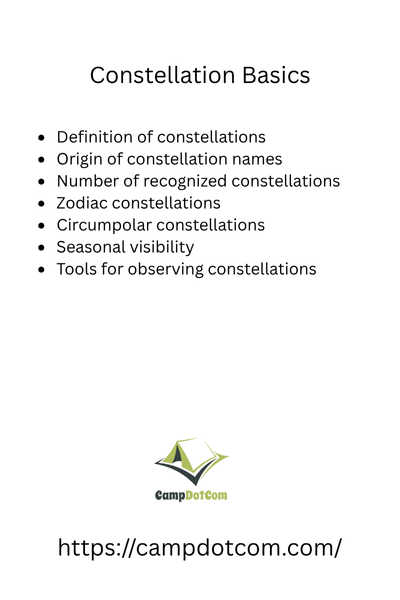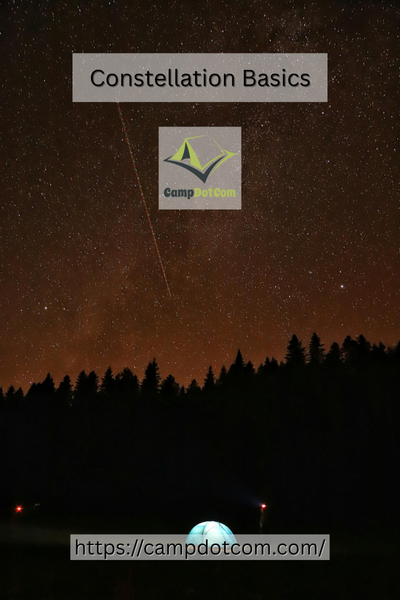Have you ever looked up at the night sky and wondered what all those twinkling dots are trying to tell you? That’s exactly how I got hooked on constellation basics—and trust me, once you start spotting patterns in the stars, it’s kinda hard to stop.
Read More About Constellation Basics

The First Time I Saw Orion
I will never forget one chilly evening in December when I stood outside with a cheap pair of binoculars and a neck cramp waiting to happen. Someone pointed out Orion’s Belt to me, three stars in a perfect row. I was stunned. Not just by how easy it was to spot, but by how cool it felt to recognize something ancient in the sky. That little moment kicked off a hobby I never saw coming.
So, if you are here to get into constellation basics, welcome to the club. It is easier than you think, way more fun than you would expect, and no, you do not need a telescope that costs more than your car.
As an Amazon Associate, I earn from qualifying purchases. Some of the links in this article are affiliate links. This means that, at zero cost to you, I will earn an affiliate commission if you click through the link and finalize a purchase.
What Are Constellations, Anyway?
Let’s keep this simple: constellations are like dot-to-dot drawings in the sky. Ancient folks connected the brighter stars with imaginary lines and turned them into pictures—like lions, scorpions, hunters, and even sea monsters. They used these pictures for storytelling, navigating, and figuring out when to plant crops. Pretty wild, right?
Now, there are 88 officially recognized constellations. Some are super easy to spot, while others look like a toddler’s attempt at connect-the-dots. But learning a few key ones will give you the confidence to find the rest.
Why Learn Constellation Basics?
Besides the bragging rights at your next camping trip? Knowing your way around the night sky is weirdly satisfying. You’ll:
- Actually understand what you’re looking at
- Impress friends or your date (yes, it’s romantic)
- Finally grasp where the Big Dipper fits into everything
It also gives you a real sense of time and place. Stars shift across the sky with the seasons, so learning a few constellations helps you stay in sync with the Earth’s rhythm. Kinda poetic for something so nerdy, right?
Starting with the Big Three
If you are just starting to explore constellation basics, I recommend beginning with three popular ones: Orion, Ursa Major also known as the Big Dipper, and Cassiopeia.
Orion is a favorite during the winter months. Look for that neat row of three stars that make up his belt, then find the bright stars above and below it called Betelgeuse and Rigel. Once you spot Orion, it becomes easy to recognize him every time.
Ursa Major is one that many people already know. It looks like a giant spoon, which is why it is often called the Big Dipper. But here is a fun fact. It is actually part of a much larger bear shaped constellation.
Cassiopeia looks like a big letter W and is best viewed in the fall. I used to think it was just a zigzag of stars, until I learned it is meant to represent a queen sitting on her throne.
More Things to Know About Constellation Basics

How to Find Them Without Losing Your Mind
You don’t need to move to the desert or hike up a mountain to see the stars. Here’s what worked for me:
- Check the weather – Cloudy nights are a buzzkill.
- Avoid city lights – Head to a park or beach if you can.
- Use a stargazing app – I swear by SkyView. Point your phone, boom: star ID.
- Give your eyes time – Takes 10–15 minutes in the dark for your night vision to kick in.
Honestly, the biggest mistake I made early on was trying to memorize star charts indoors under fluorescent lights. Spoiler alert: that doesn’t work.
Things I Wish I Knew Sooner
One thing I didn’t expect when diving into constellation basics? How peaceful it is. There’s something grounding about standing still, staring up at something bigger than you. It puts stuff in perspective. Plus, it gives you a good excuse to slow down and just be.
I also didn’t know that constellations change based on where you live. Some southern constellations you’ll never see if you’re too far north, and vice versa. It’s like a cosmic scavenger hunt that spans the whole globe.
Oh, and don’t stress about getting it perfect. Even experienced stargazers misidentify stars. It’s part of the fun.
Reflecting on Constellation Basics
Whether you’re hoping to become a full-on backyard astronomer or just want to tell the difference between a star and a plane, constellation basics are the perfect place to start. They’re simple, fascinating, and a gateway to a whole universe (literally) of knowledge.
So next time you’re outside on a clear night, don’t just glance up—really look. You might find Orion waving hello, or Cassiopeia lounging in her starry throne. And if you do, shoot me a message. I love hearing star stories.
